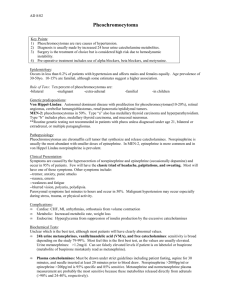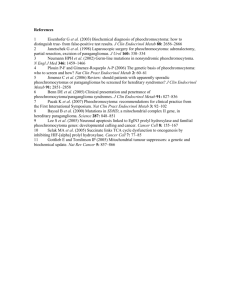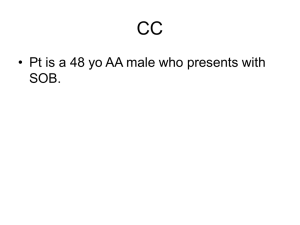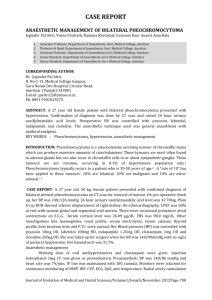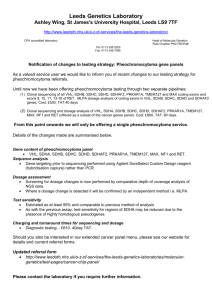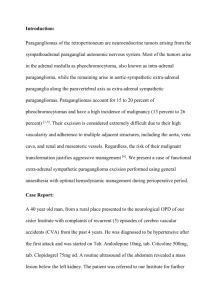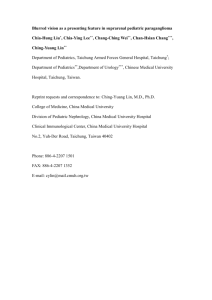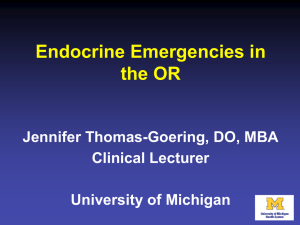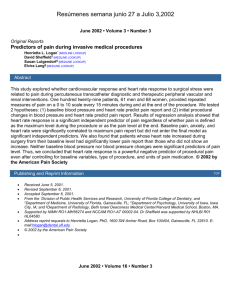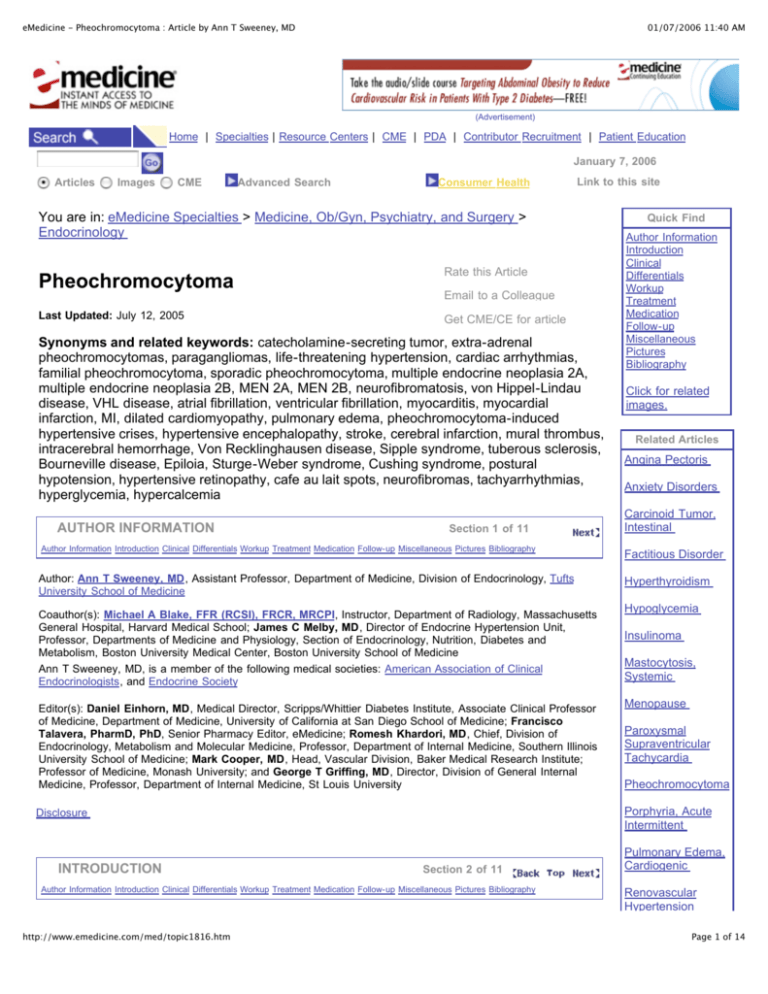
eMedicine - Pheochromocytoma : Article by Ann T Sweeney, MD
01/07/2006 11:40 AM
(Advertisement)
Home | Specialties | Resource Centers | CME | PDA | Contributor Recruitment | Patient Education
January 7, 2006
Articles
Images
CME
Advanced Search
Consumer Health
Link to this site
You are in: eMedicine Specialties > Medicine, Ob/Gyn, Psychiatry, and Surgery >
Endocrinology
Pheochromocytoma
Rate this Article
Last Updated: July 12, 2005
Get CME/CE for article
Email to a Colleague
Synonyms and related keywords: catecholamine-secreting tumor, extra-adrenal
pheochromocytomas, paragangliomas, life-threatening hypertension, cardiac arrhythmias,
familial pheochromocytoma, sporadic pheochromocytoma, multiple endocrine neoplasia 2A,
multiple endocrine neoplasia 2B, MEN 2A, MEN 2B, neurofibromatosis, von Hippel-Lindau
disease, VHL disease, atrial fibrillation, ventricular fibrillation, myocarditis, myocardial
infarction, MI, dilated cardiomyopathy, pulmonary edema, pheochromocytoma-induced
hypertensive crises, hypertensive encephalopathy, stroke, cerebral infarction, mural thrombus,
intracerebral hemorrhage, Von Recklinghausen disease, Sipple syndrome, tuberous sclerosis,
Bourneville disease, Epiloia, Sturge-Weber syndrome, Cushing syndrome, postural
hypotension, hypertensive retinopathy, cafe au lait spots, neurofibromas, tachyarrhythmias,
hyperglycemia, hypercalcemia
AUTHOR INFORMATION
Section 1 of 11
Author Information Introduction Clinical Differentials Workup Treatment Medication Follow-up Miscellaneous Pictures Bibliography
Author: Ann T Sweeney, MD, Assistant Professor, Department of Medicine, Division of Endocrinology, Tufts
University School of Medicine
Coauthor(s): Michael A Blake, FFR (RCSI), FRCR, MRCPI, Instructor, Department of Radiology, Massachusetts
General Hospital, Harvard Medical School; James C Melby, MD, Director of Endocrine Hypertension Unit,
Professor, Departments of Medicine and Physiology, Section of Endocrinology, Nutrition, Diabetes and
Metabolism, Boston University Medical Center, Boston University School of Medicine
Ann T Sweeney, MD, is a member of the following medical societies: American Association of Clinical
Endocrinologists, and Endocrine Society
Editor(s): Daniel Einhorn, MD, Medical Director, Scripps/Whittier Diabetes Institute, Associate Clinical Professor
of Medicine, Department of Medicine, University of California at San Diego School of Medicine; Francisco
Talavera, PharmD, PhD, Senior Pharmacy Editor, eMedicine; Romesh Khardori, MD, Chief, Division of
Endocrinology, Metabolism and Molecular Medicine, Professor, Department of Internal Medicine, Southern Illinois
University School of Medicine; Mark Cooper, MD, Head, Vascular Division, Baker Medical Research Institute;
Professor of Medicine, Monash University; and George T Griffing, MD, Director, Division of General Internal
Medicine, Professor, Department of Internal Medicine, St Louis University
Section 2 of 11
Author Information Introduction Clinical Differentials Workup Treatment Medication Follow-up Miscellaneous Pictures Bibliography
http://www.emedicine.com/med/topic1816.htm
Author Information
Introduction
Clinical
Differentials
Workup
Treatment
Medication
Follow-up
Miscellaneous
Pictures
Bibliography
Click for related
images.
Related Articles
Angina Pectoris
Anxiety Disorders
Carcinoid Tumor,
Intestinal
Factitious Disorder
Hyperthyroidism
Hypoglycemia
Insulinoma
Mastocytosis,
Systemic
Menopause
Paroxysmal
Supraventricular
Tachycardia
Pheochromocytoma
Porphyria, Acute
Intermittent
Disclosure
INTRODUCTION
Quick Find
Pulmonary Edema,
Cardiogenic
Renovascular
Hypertension
Page 1 of 14
eMedicine - Pheochromocytoma : Article by Ann T Sweeney, MD
01/07/2006 11:40 AM
Background: Pheochromocytoma is a rare catecholamine-secreting tumor derived from chromaffin cells. Tumors
that arise outside the adrenal gland are termed extra-adrenal pheochromocytomas or paragangliomas. Because of
excessive catecholamine secretion, pheochromocytomas may precipitate life-threatening hypertension or cardiac
arrhythmias. If the diagnosis of a pheochromocytoma is overlooked, the consequences could be disastrous, even
fatal; however, if a pheochromocytoma is found, it is potentially curable.
The term pheochromocytoma (phios means dusky, chroma means color, and cytoma means tumor) refers to the
color the tumor cells acquire when stained with chromium salts. Roux performed the first surgical resection of a
pheochromocytoma in Lausanne, Switzerland in 1926. Later the same year, Charles Mayo performed the first
surgical resection in the United States.
Pathophysiology: The clinical manifestations of a pheochromocytoma result from excessive catecholamine
secretion by the tumor. Catecholamines typically secreted, either intermittently or continuously, include
norepinephrine and epinephrine and rarely dopamine. The biological effects of catecholamines are well known.
Stimulation of alpha-adrenergic receptors results in elevated blood pressure, increased cardiac contractility,
glycogenolysis, gluconeogenesis, and intestinal relaxation. Stimulation of beta-adrenergic receptors results in an
increase in heart rate and contractility.
Catecholamine secretion in pheochromocytomas is not regulated in the same manner as in healthy adrenal tissue.
Unlike the healthy adrenal medulla, pheochromocytomas are not innervated, and catecholamine release is not
precipitated by neural stimulation. The trigger for catecholamine release is unclear, but multiple mechanisms have
been postulated, including direct pressure, medications, and changes in tumor blood flow.
Hypertension
Subarachnoid
Hemorrhage
Toxicity, Lead
Continuing
Education
CME available for
this topic. Click
here to take this
CME.
Patient Education
Click here for
patient education.
Relative catecholamine levels also differ in pheochromocytomas. Most pheochromocytomas contain norepinephrine
predominantly, in comparison with the normal adrenal medulla, which is composed of roughly 85% epinephrine.
Familial pheochromocytomas are an exception because they secrete large amounts of epinephrine. Thus, the
clinical manifestations of a familial pheochromocytoma differ from those of a sporadic pheochromocytoma.
Frequency:
In the US: Pheochromocytomas are rare, reportedly occurring in 0.05-0.2% of hypertensive individuals.
Patients may be completely asymptomatic. A retrospective study from the Mayo Clinic revealed that in 50%
of cases, the diagnosis was made at autopsy (Beard, 1983). Approximately 10% of pheochromocytomas are
discovered incidentally. Pheochromocytomas may occur in certain familial syndromes, including multiple
endocrine neoplasia (MEN) 2A and 2B, neurofibromatosis, and von Hippel-Lindau (VHL) disease.
Mortality/Morbidity: Although pheochromocytomas are rare, making the diagnosis is critical because the
malignancy rate is 10%, they may be associated with a familial syndrome, they may precipitate life-threatening
hypertension, and the patient may be cured completely with their removal.
Cardiovascular morbidity: Many cardiac manifestations are associated with pheochromocytomas.
Hypertension is the most common complication. Cardiac arrhythmias, such as atrial and ventricular
fibrillation, may occur because of excessive plasma catecholamine levels. Other complications include
myocarditis, signs and symptoms of myocardial infarction, dilated cardiomyopathy, and pulmonary edema,
either of cardiac or noncardiac origin.
Neurologic complications: A pheochromocytoma-induced hypertensive crisis may precipitate hypertensive
encephalopathy, which is characterized by altered mental status, focal neurologic signs and symptoms, or
seizures. Other neurologic complications include stroke due to cerebral infarction or an embolic event
secondary to a mural thrombus from a dilated cardiomyopathy. Intracerebral hemorrhage also may occur
because of uncontrolled hypertension.
Race: Pheochromocytomas occur in people of all races, although they are diagnosed less frequently in blacks.
Sex: Pheochromocytomas occur with equal frequency in males and females.
Age: Pheochromocytomas may occur in persons of any age. The peak incidence, however, is between the third
and the fifth decades of life. Approximately 10% occur in children. In children, 50% of pheochromocytomas are
solitary intra-adrenal, 25% are present bilaterally, and 25% are extra-adrenal.
CLINICAL
Section 3 of 11
Author Information Introduction Clinical Differentials Workup Treatment Medication Follow-up Miscellaneous Pictures Bibliography
History: The classic history of a patient with a pheochromocytoma includes spells characterized by headaches,
palpitations, and diaphoresis in association with severe hypertension. These 4 characteristics together are strongly
suggestive of a pheochromocytoma. In the absence of these 3 symptoms and hypertension, the diagnosis may be
excluded. The spells may vary in occurrence from monthly to several times per day, and the duration may vary
http://www.emedicine.com/med/topic1816.htm
Page 2 of 14
eMedicine - Pheochromocytoma : Article by Ann T Sweeney, MD
01/07/2006 11:40 AM
from seconds to hours. Typically, they worsen with time, occurring more frequently and becoming more severe as
the tumor grows.
Symptoms include the following:
Headache
Diaphoresis
Palpitations
Tremor
Nausea
Weakness
Anxiety, sense of doom
Epigastric pain
Flank pain
Constipation
Weight loss
Pheochromocytomas are known to occur in certain familial syndromes. These include MEN 2A and 2B,
neurofibromatosis (von Recklinghausen disease), and VHL disease. The MEN 2A and 2B syndromes, which
are autosomally inherited, have been found to have germline mutations in the ret proto-oncogene. The ret
proto-oncogene, located on chromosome 10, encodes a tyrosine kinase receptor involved in the regulation
of cell growth and differentiation. Pheochromocytomas occur bilaterally in the MEN syndromes in as many
as 70% of cases. Pheochromocytomas occur in 1% of neurofibromatosis cases. VHL syndrome is
associated with pheochromocytomas, cerebellar hemangioblastomas, and renal cell carcinoma.
MEN 2A (Sipple syndrome) is characterized by medullary thyroid carcinoma, hyperparathyroidism,
pheochromocytomas, and Hirschsprung disease. Over 95% of cases of MEN 2A are associated with
mutations in the ret proto-oncogene affecting 1 of 5 codons in exon 10 (codons 609, 611, 618, 620)
or exon 11 (codon 634).
Medullary thyroid carcinoma, pheochromocytoma, mucosal neurofibromatosis, intestinal
ganglioneuromatosis, Hirschsprung disease, and a marfanoid body habitus characterize MEN 2B. A
germline missense mutation in the tyrosine kinase domain of the ret proto-oncogene (exon 16, codon
918) has been reported to be present in 95% of patients with MEN 2B.
Pheochromocytoma, cerebellar hemangioblastoma, renal cell carcinoma, renal and pancreatic cysts,
and epididymal cystadenomas are associated with VHL disease. One study found that this syndrome
was present in nearly 19% of patients with pheochromocytomas (Neumann, 1993). More than 75
germline mutations have been identified in a VHL suppressor gene located on chromosome 3.
Congenital anomalies (often benign tumors) of the skin, nervous system, bones, and endocrine
glands characterize neurofibromatosis, or von Recklinghausen disease. Only 1% of patients with
neurofibromatosis have been found to have pheochromocytomas, but as many as 5% of patients with
pheochromocytomas have been found to have neurofibromatosis.
Other neuroectodermal disorders associated with pheochromocytomas include tuberous sclerosis
(Bourneville disease, epiloia) and Sturge-Weber syndrome.
Pheochromocytomas may produce calcitonin, opioid peptides, somatostatin, corticotropin, and
vasoactive intestinal peptide. Corticotropin hypersecretion has caused Cushing syndrome, and
vasoactive intestinal peptide overproduction causes watery diarrhea.
Physical: The clinical signs associated with pheochromocytomas include hypertension (which may be paroxysmal
in 50% of cases), postural hypotension, retinopathy, fever, pallor, tremor, café au lait spots, or neurofibromas.
Clinical signs
Hypertension (paroxysmal in 50% of cases)
Postural hypotension: This results from volume contraction.
http://www.emedicine.com/med/topic1816.htm
Page 3 of 14
eMedicine - Pheochromocytoma : Article by Ann T Sweeney, MD
01/07/2006 11:40 AM
Hypertensive retinopathy
Weight loss
Pallor
Fever
Tremor
Neurofibromas
Café au lait spots: These are patches of cutaneous pigmentation, which vary from 1-10 mm and
occur any place on the body. Characteristic locations include the axillae and intertriginous areas
(groin). They vary from light to dark brown, hence the name café au lait.
Tachyarrhythmias
Pulmonary edema
Cardiomyopathy
Ileus
Laboratory features
Hyperglycemia
Hypercalcemia
Erythrocytosis
Causes:
Precipitants of a hypertensive crisis
Anesthesia induction
Opiates
Dopamine antagonists
Cold medications
Radiographic contrast media
Drugs that inhibit catecholamine reuptake, such as tricyclic antidepressants and cocaine
Childbirth
DIFFERENTIALS
Section 4 of 11
Author Information Introduction Clinical Differentials Workup Treatment Medication Follow-up Miscellaneous Pictures Bibliography
Angina Pectoris
Anxiety Disorders
Carcinoid Tumor, Intestinal
Factitious Disorder
Hyperthyroidism
Hypoglycemia
Insulinoma
Mastocytosis, Systemic
Menopause
Paroxysmal Supraventricular Tachycardia
Pheochromocytoma
Porphyria, Acute Intermittent
Pulmonary Edema, Cardiogenic
Renovascular Hypertension
Subarachnoid Hemorrhage
Toxicity, Lead
http://www.emedicine.com/med/topic1816.htm
Page 4 of 14
eMedicine - Pheochromocytoma : Article by Ann T Sweeney, MD
01/07/2006 11:40 AM
Other Problems to be Considered:
Alcohol withdrawal
Labile essential hypertension
Hyperventilation
Orthostatic hypotension
Multiple pharmacologic agents (monoamine oxidase inhibitors [MAOIs], decongestants, sympathomimetics)
Illegal drug use (phencyclidine [PCP], lysergic acid diethylamide [LSD], cocaine)
Migraine headache
Autonomic neuropathy
Stroke
Toxemia of pregnancy
Polyneuropathy, organomegaly, endocrinopathy, monoclonal gammopathy, and skin changes (POEMS) syndrome
WORKUP
Section 5 of 11
Author Information Introduction Clinical Differentials Workup Treatment Medication Follow-up Miscellaneous Pictures Bibliography
Lab Studies:
The choice of diagnostic test should be based on the clinical suspicion of a pheochromocytoma. Plasma metanephrine testing has the
highest sensitivity (96%) for detecting a pheochromocytoma, but it has a lower specificity (85%) (Kudva, 2003). In comparison, a 24hour urinary collection for catecholamines and metanephrines has a sensitivity of 87.5% and a specificity of 99.7%.
High-risk patients, including those who have a genetic syndrome that predisposes them to pheochromocytoma (eg, MEN 2A or
2B, VHL disease or neurofibromatosis, a prior history of a pheochromocytoma, a family history of a pheochromocytoma),
should be screened with plasma metanephrine testing. In these scenarios, a higher-sensitivity test that lacks specificity is
justified.
A fractionated plasma free metanephrine level may be measured in a seated, ambulatory patient with a standard venipuncture.
Patients at lower risk for a pheochromocytoma, including those with flushing spells, poorly controlled hypertension, or adrenal
incidentalomas with an adrenocortical appearance, should be screened with a 24-hour urine collection for catecholamines and
metanephrines. This test has a high specificity and acceptable sensitivity.
Perform a 24-hour urine collection for creatinine, total catecholamines, vanillylmandelic acid, and metanephrines.
Measure creatinine in all collections of urine to ensure adequacy of the collection.
The collection container should be dark and acidified and should be kept cold to avoid degradation of the catecholamines.
Metanephrine levels are considered the most sensitive and specific test for a pheochromocytoma, while vanillylmandelic acid is
the least specific test and has a false-positive rate greater than 15%.
Some authors have good experience with evaluating epinephrine and norepinephrine separately (in part to confirm the total
catecholamine level and in part to determine if levels reflect the high norepinephrine-to-epinephrine ratio expected) and, for the
same reason, normetanephrines.
Dopamine levels are not useful in this test because most of the dopamine is of renal origin.
Optimally, collect urine during or immediately after a crisis.
Major physical stress and multiple drugs may interfere with the assay and cause false elevations of the metanephrines. These
drugs include tricyclic antidepressants, levodopa, labetalol, ethanol, sotalol, amphetamines, buspirone, benzodiazepines,
methyldopa, and chlorpromazine.
Compounds that decrease 24-hour urine levels of metanephrines are methyltyrosine, which inhibits tyrosine hydroxylase, the
rate-limiting enzyme in catecholamine synthesis; methylglucamine, which is present in radiocontrast media; and reserpine.
Provocative testing, although used in the past, rarely is needed. Agents used in the past to provoke a catecholamine surge include
histamine, tyramine, glucagon, and metoclopramide. Suppression tests using phentolamine and clonidine can also be used for
diagnostic purposes.
Chromogranin A is an acidic monomeric protein that is stored with and secreted with catecholamines. Plasma levels of chromogranin
A reportedly are 83% sensitive and 96% specific for identifying a pheochromocytoma. Chromogranin A levels are sometimes used to
detect recurrent pheochromocytomas.
Imaging Studies:
http://www.emedicine.com/med/topic1816.htm
Page 5 of 14
eMedicine - Pheochromocytoma : Article by Ann T Sweeney, MD
01/07/2006 11:40 AM
Over 90% of pheochromocytomas are located within the adrenal glands, and 98% are within the abdomen. Extra-adrenal
pheochromocytomas develop in the paraganglion chromaffin tissue of the sympathetic nervous system. They may occur anywhere
from the base of the brain to the urinary bladder. Common locations for extra-adrenal pheochromocytomas include the organ of
Zuckerkandl (close to origin of the inferior mesenteric artery), bladder wall, heart, mediastinum, and carotid and glomus jugulare
bodies.
Only perform imaging studies after biochemical studies have confirmed the diagnosis of a pheochromocytoma. MRI is preferred over
CT scanning. MRI has a reported sensitivity of up to 100% in detecting adrenal pheochromocytomas, does not require contrast, and
does not expose the patient to ionizing radiation. MRI is also superior to CT scanning for detecting extra-adrenal pheochromocytomas.
Typically, (approximately 70% of cases), pheochromocytomas appear hyperintense on T2-weighted images because of their high
water content.
CT scanning of the abdomen has an accuracy of 85-95% for detecting adrenal masses with a spatial resolution of 1 cm or greater.
CT scanning is less accurate for lesions smaller than 1 cm. Differentiating an adenoma from a pheochromocytoma is more difficult
using CT scanning. While most pheochromocytomas have CT attenuation greater than 10 Hounsfield units (HU), they rarely contain
sufficient intracellular fat to have an attenuation of less than 10 HU. In addition, most pheochromocytomas have enhancement loss
that is similar to that of adrenal metastases and significantly less than that of adrenal adenomas. However, in patients in whom
pheochromocytomas are strongly suspected, adrenal pheochromocytomas cannot be entirely excluded from the list of differential
diagnoses of adrenal neoplasms with less than 10-HU attenuation value and greater than 60% washout on delayed scanning.
A scan with iodine I 131–labeled metaiodobenzylguanidine (MIBG) is reserved for cases in which a pheochromocytoma is confirmed
biochemically but CT scanning or MRI do not show a tumor. The molecular structure of iodine I 123 MIBG resembles norepinephrine
and concentrates within adrenal or extra-adrenal pheochromocytomas. This isotope has a short half-life and is expensive. It frequently
is used in cases of familial pheochromocytoma syndromes, recurrent pheochromocytoma, or malignant pheochromocytoma. In the
United States, only 131 I-labeled MIBG is available, whereas 123 I MIBG is used in Europe and Japan.
A somatostatin receptor analog indium In 111 pentetreotide is less sensitive than MIBG and may be used to visualize
pheochromocytomas that do not concentrate MIBG.
Positron emission tomography (PET) scanning has been used as an imaging modality and has shown promising results. PET of 18Ffluorodeoxyglucose, which is selectively concentrated as part of the abnormal metabolism of many neoplasms, has been demonstrated
to detect occult pheochromocytomas. Pheochromocytomas usually show increased uptake on PET scanning, as do adrenal
metastases. The most impressive results to date have been with 6-[18F] fluorodopamine PET scanning and carbon 11
hydroxyephedrine PET scanning. Results of these studies suggest that PET scanning performed with both of these radioisotopes is
extremely useful in the detection and localization of pheochromocytomas. Further study results with these agents are eagerly awaited.
Other Tests:
Once the diagnosis of pheochromocytoma is made, perform additional studies to rule out a familial syndrome, such as MEN 2A or 2B.
Obtain a serum intact parathyroid hormone level and a simultaneous serum calcium level to rule out primary
hyperparathyroidism (part of MEN 2A).
Obtain a serum calcitonin level. Some investigators advocate a pentagastrin infusion test; however, genetic screening tests for
the ret proto-oncogene may obviate the need for this provocative test.
Perform screening for mutations in the ret proto-oncogene in any patient with a familial syndrome or to distinguish a sporadic
pheochromocytoma from a familial pheochromocytoma. Mutation analysis involves amplification of sequences, including exons
10, 11, 13, 14, and 16 of the ret proto-oncogene from the patient's genomic DNA, followed by sequence analysis. Particular
attention is given to specific sequences for the codons known to be hot spots for mutations causing the MEN 2A and 2B
syndromes. Over 95% of cases of MEN 2A and 85% of cases of familial medullary thyroid cancer are associated with
mutations affecting 1 of 5 codons in exon 10 (codon 609, 611, 618, and 620) or exon 11 (codon 634). Over 95% of individuals
with MEN 2B have a germline mutation in codon 918 of exon 16.
Obtain a consultation with an ophthalmologist to rule out retinal angiomas, and consider brain MRI to exclude cerebellar
hemangioblastomas (VHL disease).
Obtain a CT scan of the kidneys and pancreas to rule out cysts.
Patients with seizures, unexplained shock, weight loss, cardiomyopathy, neurofibromatosis, and/or orthostatic hypotension should be
screened for pheochromocytomas.
Procedures:
Because of the high sensitivity of MRI and CT scanning, procedures are rarely indicated for localization of pheochromocytomas.
Selective venous sampling is seldom performed to localize pheochromocytomas but has occasionally been used to detect extraadrenal pheochromocytomas that were not detected at surgery. This procedure generally is not helpful in detecting extraadrenal tumors because catecholamine levels have marked variability. An exception to this rule, however, occurs if the
http://www.emedicine.com/med/topic1816.htm
Page 6 of 14
eMedicine - Pheochromocytoma : Article by Ann T Sweeney, MD
01/07/2006 11:40 AM
norepinephrine concentration is greater than the epinephrine concentration in the venous effluent. Because the primary
catecholamine produced and stored in the adrenal gland is epinephrine, a ratio of norepinephrine to epinephrine that is greater
than 1 suggests a pheochromocytoma.
Arteriography is rarely indicated and provides little additional information compared with MRI or CT scanning. More importantly,
use of radiocontrast dye imposes a serious risk of inducing a hypertensive crisis.
Histologic Findings: Pheochromocytomas vary from 2 g to 3 kg but, on average, weigh 100 g (healthy adrenal gland weighs 4-6 g). These
tumors are well encapsulated, highly vascular, and appear reddish brown on cut section.
Histologically, the tumor cells are arranged in balls and clusters separated by endothelial-lined spaces; this classic pattern characteristic of
pheochromocytoma is termed zellballen. The cells vary in size and shape and have finely granular basophilic or eosinophilic cytoplasm. The
nuclei are round or oval with prominent nucleoli. Nuclear giantism and hyperchromasia are common.
Staging: Approximately 10% of pheochromocytomas are malignant. Direct invasion of surrounding tissue or the presence of metastases
determines malignancy. Unfortunately, no reliable clinical, biochemical, or histological features distinguish a malignant from a benign
pheochromocytoma. Factors that suggest a malignant course include large tumor size and DNA ploidy pattern (aneuploidy, tetraploidy).
Common metastatic sites include bone, liver, and lymph nodes.
TREATMENT
Section 6 of 11
Author Information Introduction Clinical Differentials Workup Treatment Medication Follow-up Miscellaneous Pictures Bibliography
Medical Care: Surgical resection of the tumor is the treatment of choice and usually results in cure of the hypertension. Careful treatment
with alpha- and beta-blockers is required preoperatively to control blood pressure and prevent intraoperative hypertensive crises.
Start alpha blockade with phenoxybenzamine 7-10 days preoperatively to allow for expansion of blood volume.
The patient should undergo volume expansion with isotonic sodium chloride solution. Encourage liberal salt intake.
Initiate a beta-blocker only after adequate alpha blockade. If beta blockade is started prematurely, unopposed alpha stimulation could
precipitate a hypertensive crisis.
Administer the last doses of oral alpha- and beta-blockers on the morning of surgery.
Surgical Care: Both an experienced anesthesiologist and an experienced surgeon are crucial to the success of the operation. Surgical
mortality rates are less than 2-3% with an experienced anesthesiologist and surgeon.
Use an arterial line, cardiac monitor, and Swan-Ganz catheter. Administer stress-dose steroids if bilateral resection is planned.
An anterior midline abdominal approach was used in the past; however, in current practice, laparoscopic adrenalectomy is the
preferred procedure for lesions smaller than 8 cm. If the pheochromocytoma is intra-adrenal, remove the entire adrenal gland. In the
case of a malignant pheochromocytoma, resect as much of the tumor as possible.
http://www.emedicine.com/med/topic1816.htm
Page 7 of 14
eMedicine - Pheochromocytoma : Article by Ann T Sweeney, MD
MEDICATION
01/07/2006 11:40 AM
Section 7 of 11
Author Information Introduction Clinical Differentials Workup Treatment Medication Follow-up Miscellaneous Pictures Bibliography
Medical therapy is used for preoperative preparation prior to surgical resection, acute hypertensive crises, and primary therapy for patients
with metastatic pheochromocytomas. Preoperative preparation requires combined alpha and beta blockade to control blood pressure and to
prevent an intraoperative hypertensive crisis. Alpha-adrenergic blockade, in particular, is required to control blood pressure and prevent a
hypertensive crisis. High circulating catecholamine levels stimulate alpha-receptors on blood vessels and cause vasoconstriction.
Phenoxybenzamine (Dibenzyline) is the preferred alpha-blocker in preparation for surgery. After effective alpha blockade, administer a betablocker. Beta-blockers are needed to control the tachycardia associated with high circulating catecholamine levels and alpha blockade. Betaadrenergic blockers are used if significant tachycardia occurs after alpha blockade. Only administer beta-adrenergic blockers after adequate
alpha blockade because unopposed alpha-adrenergic receptor stimulation can precipitate a hypertensive crisis. Noncardioselective betablockers, such as propranolol (Inderal) or nadolol (Corgard), are often used; however, cardioselective agents, such as atenolol (Tenormin)
and metoprolol (Lopressor), also may be used.
Labetalol (Trandate, Normodyne) is a noncardioselective beta-adrenergic blocker and selective alpha-adrenergic blocker that has been shown
to be effective in controlling hypertension associated with pheochromocytoma. It has also been associated with paradoxic episodes of
hypertension thought to be secondary to incomplete alpha blockade. Thus, its use in the preoperative treatment of patients with
pheochromocytoma is controversial.
During surgery, intravenous phentolamine, a rapid-acting alpha-adrenergic antagonist, is used to control blood pressure. Rapid-acting
intravenous beta-blockers, such as esmolol, are also used to normalize blood pressure. Selective alpha1-blocking agents, such as prazosin
(Minipress), terazosin (Hytrin), and doxazosin (Cardura), have more favorable adverse effect profiles and are used when long-term therapy is
required (metastatic pheochromocytoma). These medications are not used to prepare patients for surgery because of their incomplete alpha
blockade.
Drug Category: Alpha-adrenergic receptor blockers
-- At low doses, alpha-adrenergic receptor blockers may be used as
monotherapy in the treatment of hypertension. At higher doses, they may cause sodium and fluid to accumulate. As a result, concurrent
diuretic therapy may be required to maintain the hypotensive effects of alpha-receptor blockers.
Drug Name
Phenoxybenzamine hydrochloride (Dibenzyline) -- Longacting adrenergic alpha-receptor blocker that can produce
and maintain a chemical sympathectomy. Lowers supine
and upright BPs. Does not affect parasympathetic nervous
system.
Adult Dose
10 mg PO bid, increase by 10 mg qod until optimum dose
achieved
Dose range: 20-40 mg PO bid/tid
http://www.emedicine.com/med/topic1816.htm
Page 8 of 14
eMedicine - Pheochromocytoma : Article by Ann T Sweeney, MD
Pediatric Dose
Contraindications
Interactions
Pregnancy
Precautions
Drug Name
Adult Dose
Pediatric Dose
Contraindications
Interactions
Pregnancy
Precautions
Drug Name
Adult Dose
Pediatric Dose
Contraindications
Interactions
Pregnancy
01/07/2006 11:40 AM
Not established
Documented hypersensitivity; patients in whom a fall in BP
is undesirable
When used concurrently, alpha-adrenergic agonists
decrease effects of medication; beta-blockers increase
toxicity
C - Safety for use during pregnancy has not been
established.
Caution in cerebral or coronary arteriosclerosis and renal
impairment; can worsen symptoms of respiratory tract
infections
Doxazosin mesylate (Cardura) -- Quinazoline compound
that is a selective alpha1-adrenergic antagonist. Inhibits
postsynaptic alpha-adrenergic receptors, resulting in
vasodilation of veins and arterioles and decrease in total
peripheral resistance and BP.
1 mg PO qd; may increase to 2 mg qd thereafter and titrate
to higher doses; not to exceed 8 mg qd
Not established
Documented hypersensitivity
Effects decrease with coadministration of NSAIDs; effects
increase with coadministration of diuretics and
antihypertensive medications
B - Usually safe but benefits must outweigh the risks.
Caution in renal impairment; may cause marked
hypotension following first dose; rarely (<1 in 1000
patients), priapism may occur
Phentolamine mesylate (Regitine) -- Nonselective alphaadrenergic blocking agent. Drug action is transient and
alpha-adrenergic blockade incomplete. Often used
immediately prior to or during adrenalectomy to prevent or
control paroxysmal hypertension resulting from anesthesia,
stress, or operative manipulation of the tumor. Alpha1- and
alpha2-adrenergic blocking agent that blocks circulating
epinephrine and norepinephrine action, reducing
hypertension that results from catecholamine effects on
alpha-receptors.
5-15 mg IV; used to control intraoperative hypertensive
crises
0.05-1 mg/kg per dose IV/IM, repeat q2-4h prn until
hypertension is controlled; used prior to surgical removal of
a tumor or to treat acute paroxysmal hypertensive crisis
Documented hypersensitivity; coronary or cerebral
arteriosclerosis; renal impairment; myocardial infarction or a
history of a myocardial infarction
Concurrent administration of epinephrine or ephedrine may
decrease phentolamine effects; ethanol increases
phentolamine toxicity
C - Safety for use during pregnancy has not been
established.
http://www.emedicine.com/med/topic1816.htm
Page 9 of 14
eMedicine - Pheochromocytoma : Article by Ann T Sweeney, MD
Precautions
Caution in tachycardia, peptic ulcer, and gastritis;
cerebrovascular occlusions and myocardial infarctions can
occur following administration
Drug Category: Vasodilators
Drug Name
Adult Dose
Pediatric Dose
Contraindications
Interactions
Pregnancy
Precautions
01/07/2006 11:40 AM
-- Reduce systemic vascular resistance, allowing more forward flow and improving cardiac output.
Nitroprusside (Nipride) -- Direct vasodilator that relaxes
arterial vessels and venous smooth muscle. Has short halflife and effect disappears within 5 min of stopping infusion.
May use to control paroxysmal hypertension
intraoperatively. Produces vasodilation and increases
inotropic activity of heart. At higher dosages may
exacerbate myocardial ischemia by increasing heart rate.
Begin infusion: 0.3-0.5 mcg/kg/min IV; use increments of
0.5 mcg/kg/min, titrate to desired effect
Average dose: 1-6 mcg/kg/min IV; infusion rates >10
mcg/kg/min may lead to cyanide toxicity
Administer as in adults
Documented hypersensitivity; idiopathic hypertrophic
subaortic stenosis; atrial fibrillation or flutter
None reported
C - Safety for use during pregnancy has not been
established.
Caution in increased intracranial pressure, hepatic failure,
severe renal impairment, and hypothyroidism; in renal or
hepatic insufficiency, levels may increase and can cause
cyanide toxicity; sodium nitroprusside can lower BP (only
use in patients with mean arterial pressures >70 mm Hg)
Drug Category: Beta-adrenergic receptor blocking agents
-- These agents compete with beta-adrenergic agonists for
available beta-receptor sites.
Drug Name
Adult Dose
Pediatric Dose
Contraindications
Interactions
Propranolol hydrochloride (Inderal) -- Nonselective betaadrenergic receptor blocker. After primary treatment with an
alpha-receptor blocker, may be used as adjunctive therapy
if control of tachycardia becomes necessary before or
during surgery. May be used to treat excessive betareceptor stimulation in patients with inoperable metastatic
pheochromocytoma. Has membrane-stabilizing activity and
decreases automaticity of contractions.
Not suitable for emergency treatment of hypertension. Do
not administer IV in hypertensive emergencies.
Preoperative preparation: 10 mg PO tid/qid, titrate up prn;
60 mg/d in divided doses is usual dose required
During surgery: 1-3 mg IV to control tachycardia (careful
monitoring)
Metastatic pheochromocytoma: 30 mg PO in divided doses
1 mg/kg PO qd, titrate prn; IV not recommended
Documented hypersensitivity; uncompensated congestive
heart failure; bradycardia; cardiogenic shock; AV
conduction abnormalities
Coadministration with aluminum salts, barbiturates,
NSAIDs, penicillins, calcium salts, cholestyramine, and
rifampin may decrease effects; calcium channel blockers,
cimetidine, loop diuretics, and MAOIs may increase toxicity;
toxicity of hydralazine, haloperidol, benzodiazepines, and
http://www.emedicine.com/med/topic1816.htm
Page 10 of 14
eMedicine - Pheochromocytoma : Article by Ann T Sweeney, MD
Pregnancy
Precautions
Drug Name
Adult Dose
Pediatric Dose
Contraindications
Interactions
Pregnancy
Precautions
toxicity of hydralazine, haloperidol, benzodiazepines, and
phenothiazines may increase
B - Usually safe but benefits must outweigh the risks.
Beta-adrenergic blockade may decrease signs of acute
hypoglycemia and hyperthyroidism; abrupt withdrawal may
exacerbate symptoms of hyperthyroidism, inducing thyroid
storm; withdraw drug slowly and monitor closely
Atenolol (Tenormin) -- Selectively blocks beta1-receptors
with little or no affect on beta2 types.
50 mg PO qd; increase to 100 mg/d if necessary
1-2 mg/kg PO qd
Documented hypersensitivity; congestive heart failure;
pulmonary edema; cardiogenic shock; AV conduction
abnormalities; heart block (without a pacemaker)
Coadministration with aluminum salts, barbiturates, calcium
salts, cholestyramine, NSAIDs, penicillins, and rifampin may
decrease effects; haloperidol, hydralazine, loop diuretics,
and MAOIs may increase toxicity
C - Safety for use during pregnancy has not been
established.
Beta-adrenergic blockade may reduce symptoms of acute
hypoglycemia and mask signs of hyperthyroidism; abrupt
withdrawal may exacerbate symptoms of hyperthyroidism
and cause thyroid storm; monitor patients closely and
withdraw drug slowly; during an IV, carefully monitor BP,
heart rate, and ECG
Drug Category: Tyrosine kinase inhibitors
Drug Name
Adult Dose
Pediatric Dose
Contraindications
Interactions
01/07/2006 11:40 AM
-- Used to inhibit catecholamine synthesis in pheochromocytoma.
Metyrosine (Demser) -- Inhibits tyrosine hydroxylase, the
rate-limiting step in catecholamine synthesis. In patients
with pheochromocytoma, administration of metyrosine
reduces catecholamine biosynthesis by 35-80% as
measured by urinary catecholamine levels. Indicated in
malignant pheochromocytoma or pheochromocytoma when
surgery is contraindicated. Inhibits catecholamine synthesis
in pheochromocytoma. Can be useful in patients who are
refractory to phenoxybenzamine therapy, or can be
administered as adjunct to phenoxybenzamine therapy.
250 mg PO qid initially, titrated up by 250-500 qd prn; not to
exceed 4 g qd in divided doses; monitor clinical symptoms
and catecholamine excretion
Optimal benefits: 2-3 g PO divided qid (typically)
Preoperatively: Administer for at least 5-7 d
<12 years: Not established
>12 years: Administer as in adults
Documented hypersensitivity
Ethanol, TCAs, opiate agonists, barbiturates,
benzodiazepines, H1-blockers, or other CNS agents can
result in additive sedative effects; extrapyramidal effects of
haloperidol, metoclopramide, molindone, or phenothiazines
can be increased
http://www.emedicine.com/med/topic1816.htm
Page 11 of 14
eMedicine - Pheochromocytoma : Article by Ann T Sweeney, MD
Pregnancy
Precautions
01/07/2006 11:40 AM
C - Safety for use during pregnancy has not been
established.
Instruct patients to maintain adequate fluid balance (daily
urinary volume of >2 L) to minimize risk of metyrosineinduced crystalluria; increase fluid intake if crystalluria
occurs; if crystalluria persists, dosage reduction or
discontinuation may be necessary; precipitates
extrapyramidal symptoms, including increased salivation,
tremor, and speech difficulty; other more infrequent effects
include trismus and pseudoparkinsonism; can precipitate or
worsen mental depression, resulting in effects such as
anxiety, tremulousness, confusion, and psychic
disturbances; other adverse effects may include dry mouth,
impotence or ejaculation dysfunction (failure to ejaculate),
hematologic toxicity, galactorrhea, swelling of the breasts,
peripheral edema, and urticaria
FOLLOW-UP
Section 8 of 11
Author Information Introduction Clinical Differentials Workup Treatment Medication Follow-up Miscellaneous Pictures Bibliography
Further Inpatient Care:
Test plasma free metanephrines 2 weeks postoperatively. If results are within the reference range, patient survival approaches agematched controls.
Assure resolution of the hypertension and any associated complications.
Further Outpatient Care:
Obtain plasma metanephrine levels yearly for 5 years. Assure that blood pressure is under control.
The 5-year survival rate for people with nonmalignant pheochromocytomas is greater than 95%. In those with malignant
pheochromocytomas, the 5-year survival rate is less than 50%.
Patient Education:
For excellent patient education materials, see eMedicinehealth.com and see the patient education article High Blood Pressure.
MISCELLANEOUS
Section 9 of 11
Author Information Introduction Clinical Differentials Workup Treatment Medication Follow-up Miscellaneous Pictures Bibliography
Medical/Legal Pitfalls:
The major pitfalls are in not considering the diagnosis in a timely manner or in ordering a test that provokes a hypertensive crisis with
complications. The symptoms of pheochromocytoma may be quite vague and misrepresented by the patient. Most difficult are the true
episodic secreting pheochromocytomas wherein the blood pressure may appear normal between paroxysms. Because this constitutes
failure to diagnose a potentially curable problem with otherwise life-threatening consequences, pheochromocytomas have attracted
litigation.
Special Concerns:
Pregnancy
Pheochromocytoma occurring during pregnancy carries a grave prognosis, with maternal and fetal mortality rates of 48% and
55%, respectively.
Maternal mortality is virtually eliminated and the fetal mortality rate is reduced to 15% if the diagnosis is made antenatally.
Administer alpha-adrenergic blockade (phenoxybenzamine) as soon as the diagnosis is confirmed.
Surgically remove the tumor as soon as possible during the first 2 trimesters after proper preparation. Pregnancy need not be
terminated.
Spontaneous abortion is very likely.
http://www.emedicine.com/med/topic1816.htm
Page 12 of 14
eMedicine - Pheochromocytoma : Article by Ann T Sweeney, MD
01/07/2006 11:40 AM
During the third trimester, as soon as fetal lung maturity is confirmed, perform surgical removal of the tumor and follow with
cesarean delivery.
PICTURES
Section 10 of 11
Author Information Introduction Clinical Differentials Workup Treatment Medication Follow-up Miscellaneous Pictures Bibliography
Caption: Picture 1. Pheochromocytoma. Abdominal CT scan demonstrating left
suprarenal mass of soft tissue attenuation representing a paraganglioma.
View Full Size Image
eMedicine Zoom View (Interactive!)
Picture Type: CT
Caption: Picture 2. Pheochromocytoma. Axial T2-weighted MRI showing large left
suprarenal mass of high signal intensity on a T2-weighted image representing a
pheochromocytoma.
View Full Size Image
eMedicine Zoom View (Interactive!)
Picture Type: MRI
BIBLIOGRAPHY
Section 11 of 11
Author Information Introduction Clinical Differentials Workup Treatment Medication Follow-up Miscellaneous Pictures Bibliography
Beard CM, Sheps SG, Kurland LT, et al: Occurrence of pheochromocytoma in Rochester, Minnesota, 1950 through 1979. Mayo Clin
Proc 1983 Dec; 58(12): 802-4[Medline].
Blake MA, Krishnamoorthy SK, Boland GW, et al: Low-density pheochromocytoma on CT: a mimicker of adrenal adenoma. AJR Am J
Roentgenol 2003 Dec; 181(6): 1663-8[Medline].
Blake MA, Kalra MK, Maher MM, et al: Pheochromocytoma: an imaging chameleon. Radiographics 2004 Oct; 24 Suppl 1: S8799[Medline].
Bravo EL, Gifford RW Jr: Current concepts. Pheochromocytoma: diagnosis, localization and management. N Engl J Med 1984 Nov
15; 311(20): 1298-303[Medline].
Bravo EL, Gifford RW Jr: Pheochromocytoma. Endocrinol Metab Clin North Am 1993 Jun; 22(2): 329-41[Medline].
Cruz SR, Colwell JA: Pheochromocytoma and ileus. JAMA 1972 Feb 21; 219(8): 1050-1[Medline].
Eisenhofer G, Lenders JW, Linehan WM, et al: Plasma normetanephrine and metanephrine for detecting pheochromocytoma in von
Hippel-Lindau disease and multiple endocrine neoplasia type 2. N Engl J Med 1999 Jun 17; 340(24): 1872-9[Medline].
Forman BH, Marban E, Kayne RD, et al: Ectopic ACTH syndrome due to pheochromocytoma: case report and review of the literature.
Yale J Biol Med 1979 Mar-Apr; 52(2): 181-9[Medline].
Gifford RW, Kvale WF, Maher FT: Clinical features, diagnosis and treatment of pheochromocytoma: A review of 76 cases. Mayo Clin
Proc 1964 Apr; 39: 281-302[Medline].
Heath H 3rd, Edis AJ: Pheochromocytoma associated with hypercalcemia and ectopic secretion of calcitonin. Ann Intern Med 1979
Aug; 91(2): 208-10[Medline].
Keiser HR: Pheochromocytoma and other diseases of the sympathetic nervous system. In: Becker KL, Bilezikian JP, Bremner WJ, et
al, eds. Principles and Practice of Endocrinology and Metabolism. 2nd ed. Philadelphia, Pa: JB Lippincott; 1995. 762-70.
Kudva YC, Young WF Jr: Lightheaded spells and hypertension. Lancet 1997 Oct 18; 350(9085): 1140[Medline].
Kudva YC, Sawka AM, Young WF Jr: Clinical review 164: The laboratory diagnosis of adrenal pheochromocytoma: the Mayo Clinic
experience. J Clin Endocrinol Metab 2003 Oct; 88(10): 4533-9[Medline].
Lenders JW, Keiser HR, Goldstein DS, et al: Plasma metanephrines in the diagnosis of pheochromocytoma. Ann Intern Med 1995 Jul
15; 123(2): 101-9[Medline].
Lenders JW, Pacak K, Walther MM, et al: Biochemical diagnosis of pheochromocytoma: which test is best? JAMA 2002 Mar 20;
287(11): 1427-34[Medline].
Manger WM, Gifford RW: Clinical and Experimental Pheochromocytoma. 2nd ed. Cambridge, Mass: Blackwell Science; 1996.
http://www.emedicine.com/med/topic1816.htm
Page 13 of 14
eMedicine - Pheochromocytoma : Article by Ann T Sweeney, MD
01/07/2006 11:40 AM
Mayo CH: Paroxysmal hypertension with tumor of the retroperitoneal nerve: report of a case. JAMA 1927; 89: 1047-50.
Neumann HP, Berger DP, Sigmund G, et al: Pheochromocytomas, multiple endocrine neoplasia type 2, and von Hippel-Lindau
disease. N Engl J Med 1993 Nov 18; 329(21): 1531-8[Medline].
Samaan NA, Hickey RC: Pheochromocytoma. Semin Oncol 1987 Sep; 14(3): 297-305[Medline].
Sheps SG, Jiang NS, Klee GG, van Heerden JA: Recent developments in the diagnosis and treatment of pheochromocytoma. Mayo
Clin Proc 1990 Jan; 65(1): 88-95[Medline].
Sweeney AT, Malabanan AO, Blake MA, et al: Megacolon as the presenting feature in pheochromocytoma. J Clin Endocrinol Metab
2000 Nov; 85(11): 3968-72[Medline].
Szolar DH, KorobkinM, Reittner P, et al: Adrenocortical carcinomas and adrenal pheochromocytomas: mass and enhancement loss
evaluation at delayed contrast-enhanced CT. Radiology 2005; 234(2): 479-85[Medline].
Trampal C, Engler H, Juhlin C, et al: Pheochromocytomas: detection with 11C hydroxyephedrine PET. Radiology 2004; 230: 423428[Medline].
van Heerden JA: First encounters with pheochromocytoma. The story of Mother Joachim. Am J Surg 1982 Aug; 144(2): 2779[Medline].
Young WF Jr, Maddox DE: Spells: in search of a cause. Mayo Clin Proc 1995 Aug; 70(8): 757-65[Medline].
NOTE:
Medicine is a constantly changing science and not all therapies are clearly established. New research changes drug and treatment therapies daily. The authors, editors, and
publisher of this journal have used their best efforts to provide information that is up-to-date and accurate and is generally accepted within medical standards at the time of
publication. However, as medical science is constantly changing and human error is always possible, the authors, editors, and publisher or any other party involved with the
publication of this article do not warrant the information in this article is accurate or complete, nor are they responsible for omissions or errors in the article or for the results of using
this information. The reader should confirm the information in this article from other sources prior to use. In particular, all drug doses, indications, and contraindications should be
confirmed in the package insert. FULL DISCLAIMER
Pheochromocytoma excerpt
© Copyright 2005, eMedicine.com, Inc.
About Us | Privacy | Terms of Use | Contact Us | Advertise | Institutional Subscribers
We subscribe to the
HONcode principles of the
Health On the Net Foundation
http://www.emedicine.com/med/topic1816.htm
1996-2005 eMedicine.com, Inc.
All Rights Reserved.
Page 14 of 14

